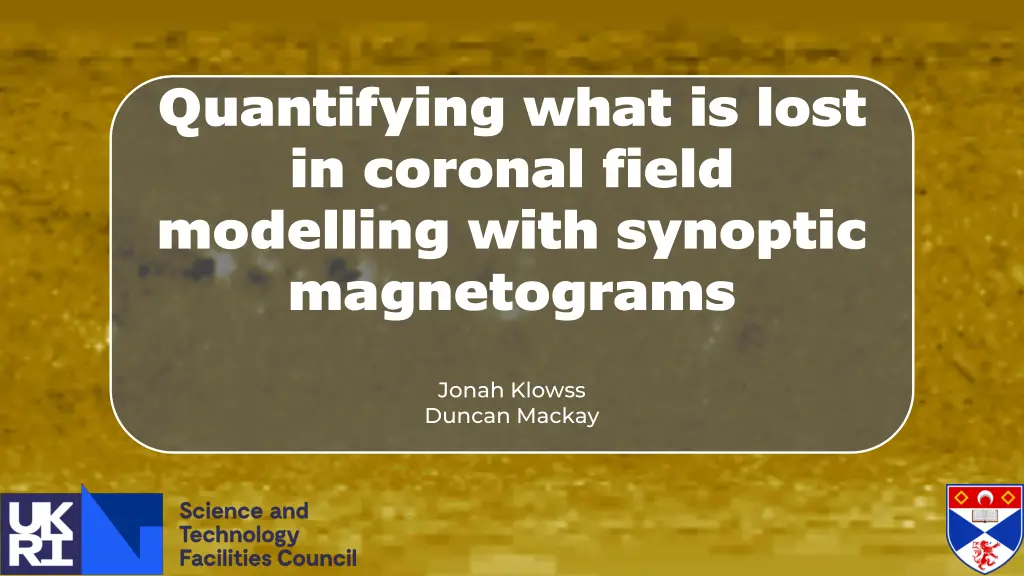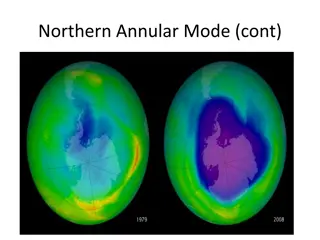
Understanding Coronal Field Modeling With Synoptic Magnetograms
Explore the implications of what is lost in coronal field modeling with synoptic magnetograms, delve into the open flux problem, non-potential mechanisms, and helicity condensation in solar research. Discover insights from studies by Klowss, Mackay, and others in this Astrophysical Journal compilation.
Download Presentation

Please find below an Image/Link to download the presentation.
The content on the website is provided AS IS for your information and personal use only. It may not be sold, licensed, or shared on other websites without obtaining consent from the author. If you encounter any issues during the download, it is possible that the publisher has removed the file from their server.
You are allowed to download the files provided on this website for personal or commercial use, subject to the condition that they are used lawfully. All files are the property of their respective owners.
The content on the website is provided AS IS for your information and personal use only. It may not be sold, licensed, or shared on other websites without obtaining consent from the author.
E N D
Presentation Transcript
Quantifying what is lost in coronal field modelling with synoptic magnetograms Jonah Klowss Duncan Mackay
Contents Contents The Open Flux Problem The Open Flux Problem Helicity condensation Helicity condensation Mathematical models Mathematical models Results Results Reference Sun simulation Comparison with synthetic synoptic magnetograms Conclusions Conclusions
The Open Flux The Open Flux The part of the solar magnetic field extending out beyond 2.5? . Source of: - high speed solar wind - interplanetary magnetic field Capable of influencing geomagnetic interactions at Earth. Guides propagation of charged particles and shields Earth from high energy cosmic rays.
The Open Flux (Problem) The Open Flux (Problem) Measured in situ open flux consistently higher than that in realistic global coronal field simulations. Non-potential simulations can reduce this discrepancy. Injection of currents into the low corona through non-potential mechanisms such as differential rotation can cause increases in open flux. Other non-potential mechanisms also exist. Mackay & Upton (2022) Mackay, D. H. & Upton, L. A. (2022). A Comparison of Global Magnetofrictional Simulations of the 2015 March 20 Solar Eclipse. The Astrophysical Journal, 939, 22.
Non Non- -potential Open Flux Enhancement potential Open Flux Enhancement One of these non-potential mechanisms could be helicity condensation. The contribution from helicity condensation has been studied with a static photospheric configuration over solar cycle timescales These studies used synoptic magnetograms to constrain the photosphere, which are an averaged representation of the surface field. Klowss, J. J. & Mackay, D. H. (2025). Investigating the Possible Contribution of Helicity Condensation to the Ambient Increase in Solar Open Flux. The Astrophysical Journal, 987, 1.
Helicity Condensation Helicity Condensation Vortical motions of convective cells rotating on the photospheric surface. Antiparallel field in adjacent cells leads to reconnection, redistributing the helicity onto larger scales ( (Antiochos Antiochos, 2013) , 2013). Introduces a horizontal twist component that is then propagated upward into the corona by the Lorentz force. Antiochos, S. K. (2013). Helicity condensation as the origin of coronal and solar wind structure. The Astrophysical Journal, 772, 72.
Modelling Approaches Modelling Approaches Reference Sun Synthetic synoptic magnetograms Continuous simulation for 8030 days With bipole emergence and surface flux transport Different sources of non-potentiality: > Helicity condensation >? = 0 s 1 >? = 1 10 6 s 1 >? = 2.5 10 6 s 1 >? = 5 10 6 s 1 Produced from Reference Sun simulation: 27.25 day representation of global field at surface (not instantaneous) instantaneous) Used a static boundary condition for PFSS modelling and static 30-day non-potential simulations No surface flux transport or bipole emergence Only helicity condensation simulations: >? = 0 s 1 >? = 1 10 6 s 1 >? = 2.5 10 6 s 1 >? = 5 10 6 s 1 (not > Twist in field of emerging bipoles >? = 0.4 Provides instantaneous measurement of open flux Consistent with most open flux studies
Modelling Approaches Modelling Approaches Reference Sun Synthetic synoptic magnetograms Surface flux transport: ??s ?? Differential rotation: Continuous simulation for 8030 days With bipole emergence and surface flux transport Different sources of non-potentiality: > Helicity condensation >? = 0 s 1 >? = 1 10 6 s 1 >? = 2.5 10 6 s 1 >? = 5 10 6 s 1 ?(?max+ ?min 2?) 2 ?max+ ?min Produced from Reference Sun simulation: 27.25 day representation of global field at surface (not instantaneous) instantaneous) Used a static boundary condition for PFSS modelling and static 30-day non-potential simulations No surface flux transport or bipole emergence Only helicity condensation simulations: >? = 0 s 1 >? = 1 10 6 s 1 >? = 2.5 10 6 s 1 >? = 5 10 6 s 1 (not = ?s ?? ? s ??+ ?b ??= ? ?sin ? ? = 0.18 2.30cos2? 1.62cos4? deg day 1 Meridional flow: ??= ? cos cos ? > Twist in field of emerging bipoles >? = 0.4 Surface diffusion: ? = 600 km2 s 1 Provides instantaneous measurement of open flux Consistent with most open flux studies
Modelling Approaches Modelling Approaches Reference Sun Synthetic synoptic magnetograms Bipole emergence at (??,??,??): ??= ?0?0.5?? Continuous simulation for 8030 days With bipole emergence and surface flux transport Different sources of non-potentiality: > Helicity condensation >? = 0 s 1 >? = 1 10 6 s 1 >? = 2.5 10 6 s 1 >? = 5 10 6 s 1 ?? 2 Produced from Reference Sun simulation: 27.25 day representation of global field at surface (not instantaneous) instantaneous) Used a static boundary condition for PFSS modelling and static 30-day non-potential simulations No surface flux transport or bipole emergence Only helicity condensation simulations: >? = 0 s 1 >? = 1 10 6 s 1 >? = 2.5 10 6 s 1 >? = 5 10 6 s 1 (not ?0??+ 4????? 2? 2?, ?0 2+ ?? ?0 2 ??= 2??0?0.51 ?? ? 2?, 2 ??= ?0?0.5 ?? ?0? ?+ 4????? 2+ ?? + ?? 2? 2?, ?0 2 2/?0 2 ? When bipole self-helicity is included, we use ? = 0.4 Provides instantaneous measurement of open flux Consistent with most open flux studies
Modelling Approaches Modelling Approaches Reference Sun Synthetic synoptic magnetograms Coronal model: Continuous simulation for 8030 days With bipole emergence and surface flux transport Different sources of non-potentiality: > Helicity condensation >? = 0 s 1 >? = 1 10 6 s 1 >? = 2.5 10 6 s 1 >? = 5 10 6 s 1 ?sg= ????, 0, Produced from Reference Sun simulation: 27.25 day representation of global field at surface (not instantaneous) instantaneous) Used a static boundary condition for PFSS modelling and static 30-day non-potential simulations No surface flux transport or bipole emergence Only helicity condensation simulations: >? = 0 s 1 >? = 1 10 6 s 1 >? = 2.5 10 6 s 1 >? = 5 10 6 s 1 (not ?? ??= ? ? + ?sg Coronal velocities: ? =1 ? ? ?2+ ?0exp 2.5? ? Helicity condensation: ? ? ?w ? ?2? ? = ? otherwise, 2 > Twist in field of emerging bipoles >? = 0.4 Provides instantaneous measurement of open flux Consistent with most open flux studies
Modelling Approaches Modelling Approaches Reference Sun Synthetic synoptic magnetograms Coronal model: Continuous simulation for 8030 days With bipole emergence and surface flux transport Different sources of non-potentiality: > Helicity condensation >? = 0 s 1 >? = 1 10 6 s 1 >? = 2.5 10 6 s 1 >? = 5 10 6 s 1 ?sg= ????, 0, ?? ??= ? ? + ?sg Coronal velocities: ? =1 ? ? ?2+ ?0exp 2.5? ? Helicity condensation: ? ? ?w ? ?2? ? = ? otherwise, 2 > Twist in field of emerging bipoles >? = 0.4 Provides instantaneous measurement of open flux
Reference Sun Reference Sun The ?RO,?RO,?RO simulations correspond to the ? = 0 s 1 simulation (radial outflow only). Left: absolute amounts Right: ratio increase relative to radial outflow simulation (e.g. ?/?RO). PFSS Radial outflow only ? = 1 10 6 s 1 ? = 2.5 10 6 s 1 ? = 5 10 6 s 1 ? = 0.4
Reference Sun vs Synthetic magnetograms Reference Sun vs Synthetic magnetograms (a) Open Flux (b) Energy Left: Reference Sun simulations (RS) Right: synthetic synoptic magnetograms (SSM) Increase from PFSS model to SSM simulations is roughly half of the increase from PFSS model to the RS simulations.
Conclusions Conclusions Comparison between Reference Sun simulations and magnetogram simulations to quantify the data loss due to limitations in observations. No difference between PFSS models from either synthetic synoptic magnetograms or instantaneous Reference Sun Reference Sun simulations cause twice as much enhancement on PFSS models as simulations with fixed surface flux distribution and limited data.
Magnetofrictional model Magnetofrictional model Method for introducing non-linear force free fields (NLFFFs) in the corona Introduce an artificial, dissipation-like frictional term into the MHD equation of motion, which reduces so that: The corona responds dynamically to changes in the field: where Coronal flow velocities Statistically-averaged helicity condensation
Open Open footpoint footpoint area area ? = 5 10 6 s 1 simulations Top panels show longitudinally-averaged footpoint areas, with blue being negative and red being positive Open Flux footpoints. Bottom panels show difference relative to the top middle (SSM) panel, in absolute or negative). absolute Open Flux (discounting positive
Method for introducing non-linear force free fields (NLFFFs) in the corona Introduce an artificial, dissipation-like frictional term into the MHD equation of motion, which reduces so that: Magnetofrictional model Magnetofrictional model The corona responds dynamically to changes in the field: where Coronal flow velocities Statistically-averaged helicity condensation
Area enhancements Area enhancements Key issue: increasing the magnitude of open flux without increasing the open footpoint area by too much. Left: helicity condensation simulations Right: PFSS models with reduced ?SS Enhancements to open flux match but open footpoint area increases by less.
Reference Sun Reference Sun Solar minimum Solar minimum Radial outflow only ? = 1 10 6 s 1 ? = 2.5 10 6 s 1 ? = 5 10 6 s 1 ? = 0.4 No strong relationship between helicity condensation and open flux at solar minimum. Stronger relationship between energy/current and helicity condensation rate. Bipole self-helicity sits around the ? = 1 10 6 s 1 and ? = 2.5 10 6 s 1 profiles.
Reference Sun Reference Sun Solar maximum Solar maximum Radial outflow only ? = 1 10 6 s 1 ? = 2.5 10 6 s 1 ? = 5 10 6 s 1 ? = 0.4 Open flux, energy, and current consistently trend higher as helicity condensation rate is increased. Considerably more bipole emergence activity. Energy and current profiles fluctuate more due to this increase in emergence activity.
Enhancement: Area and magnitude Enhancement: Area and magnitude Solid green: Reference Sun open flux (? = 5 10 6 s 1) Dashed green: Synthetic magnetogram open flux (? = 5 10 6 s 1) Dashed pink: PFSS open flux
Enhancement: Area and magnitude Enhancement: Area and magnitude Green: ?RS/???? ratio in open area Grey: ?RS/???? ratio in open flux magnitude






















